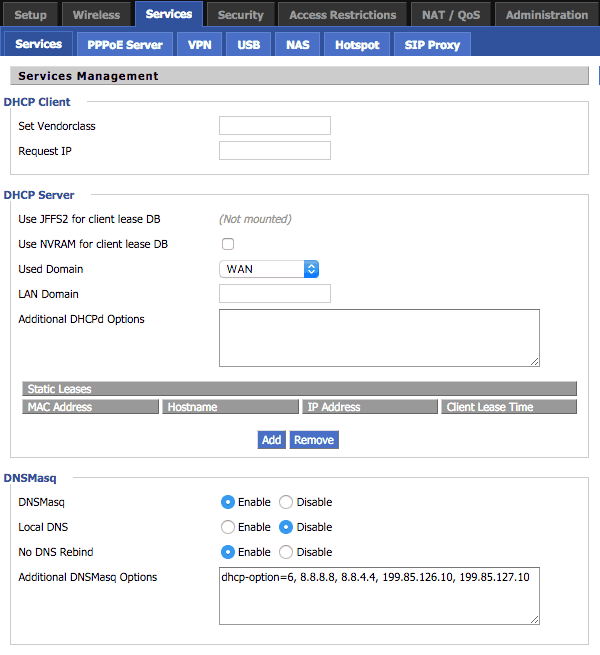
It will establish a connection to the VPN server by forwarding to 192.168.111.2. The router NAT will then detect an incoming pkt using port 1723. The request will hit the router external IP (the one provided by your ISP). When you are off site you will try to connect to the VPN (using 1723 for pptp by default). (An IP from your network that is not used by any computer or the router).Įxample (assuming DD-WRT LAN address 192.168.111.1): 192.168.111.2 Them go back to the latest working setting. If its working increase the MTU to the values the connection doesnt work anymore correctly. Set them to 1300 and ceck the connection. DSL, Coax, Fiber, etc, you will have to adjust the values to the correct working settings. If you like to use pptp on other (wan) connections, e.g. The default values are valid for ethernet paket networks with an MTU of 1500 Byte. These settings are very important for correct working connections. Setting DNS2 is optional.Īdd your local WINS servers. When encyption is disabled encryption to clients is allwed but not forced.Īdd your local/wan DNS server. This will increase cpu load a lot and is not recommend.ĭD-WRT forces clients to use encyption with 128bit. When enabled bcrelay will relay all broadcast messages to the default bridge network. In disabled mode pptd-server does set proxy-arp which works for broadcasting in most cases. There are some options you need to know if you would like to setup e.g.

Many other operating systems will not work and trying to connect from a LAN port will not work.Īny questions can be posted on the forums or go to log in, search for "Marcelo Semino" (Public Figure), Became a fan of me, an then I will help you with your VPN problem for free.
Connect to dd wrt vpn server mac windows#
NOTE: After you have done this, only computers the Windows Operating System will be able to connect through the WAN port of the router. Once you have completed the data input go down an click on "Save Settings" to save changes, now on the page "Settings Are Succesfull" click on "Continue" and again on "SERVICES" tab, where you doublecheck the values of your PPTP server.Finally, go down, Save Settings, and then click on "REBOOT ROUTER", this step is very important, no matter what you have configured, if you dont reboot router, settings will not work.Descriptions of options can be found below. While still in the "SERVICES" sub-tab, complete the options you need.After you see the message "Settings Are Successful" click "Continue" (In newer versions, this step may be skipped because the options are automatically shown when you click.) Click enable and then click "Save Settings").(In v24 and higher PPTP is a sub-tab in the Services main tab.) This option is disabled by default, so to setup PPTP, you click "ENABLE". Go down and you will see "PPTP Server".Goto the Web Administration and goto the "ADMINISTRATION" Tab, and the "SERVICES" sub-tab.All other routers have the pptp-server per default. On BCM routers make sure you have flashed at least the "mini" firmware to your router.This will add support for x.509 certs which will increase the pptp security a lot (depending on the cert strength) and brings it back to enterprise class security. With this ticket we request eap-tls authentication in DD-WRT.

Just be sure to use strong passwords of >12 charaters. Since the the default 192.168.1.0 subnet is commonly used, you should set an unusual other range for your LAN, like 192.168.111.0 (or something random in the vast 10.0.0.0 block) in Setup > Basic Setup.Ī PPTP implementation may not fulfill enterprise class security requirements and in fact is has some security flaws and is considered deprecated, but for home-use or for implementations that do not rely on high encryption grades should be sufficient. To avoid IP address conflicts, IP addresses on your LAN should be different from LAN addresses at remote VPN points. One of the big advantages of using PPTP over OpenVPN with DD-WRT is that PPTP is supported out-of-the-box for 4Mb firmware images and up.įor an alternative, have a look at the OpenVPN article. PPTP has been made obsolete by Layer 2 Tunneling Protocol (L2TP), IPSec and OpenVPN, but its still commonly used and natively supported by a lage scale of routers and clients. The Point-to-Point Tunneling Protocol (PPTP) is a method for implementing virtual private networks.



 0 kommentar(er)
0 kommentar(er)
